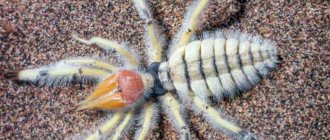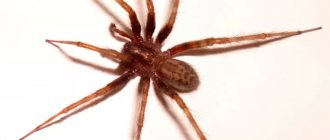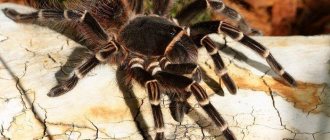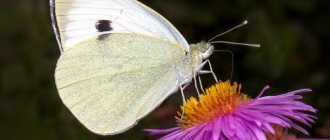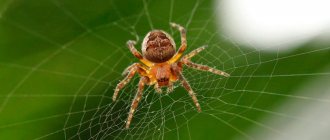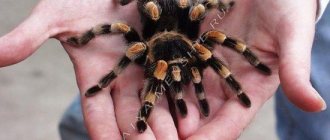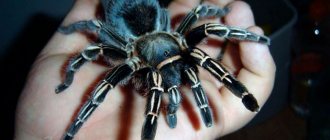Appearance, color and size
Tarantula spiders are a family of arachnids called Theraphosidae (the so-called “true tarantulas”), the members of which are so named because of the nuances of the “first encounter”.
At the end of the 18th century, one of these spiders was spotted eating a hummingbird in a Venezuelan forest, and since then it has long been believed that they feed exclusively on birds. Well, “goliath” is an unofficial but widespread name for tarantula spiders of the species Theraphosa blondi.
Familiarize yourself with the types of spiders.
Representatives of this species are considered the largest spiders on the planet, for which they were named after the famous biblical character, famous for his height and strength.
The average body size of a goliath is about 10 cm, but together with its thick hairy legs, the arthropod can reach 28 cm. Female individuals are traditionally larger than their “men” and seem much more massive than them.
Body color varies from light brown to reddish brown. The spider's body itself is represented by a connected cephalothorax and abdomen, covered with a dense chitinous exoskeleton.
It serves as reliable protection against various injuries and retains moisture in the body, which is especially important for species living in arid zones. The head and chest of the tarantula are protected by a shield-frame, and on its front part there are eyes (by the way, the arthropod has 4 pairs of them).
The organs of the digestive tract and reproductive system are located in the abdominal part, at the end of which there are arachnoid appendages (2–6 pairs).
Did you know? The largest tarantula spider found is considered to be Theraphosa blondi, whose limb span reached 28 cm (it was found in the 60s of the last century).
However, he is not the only record holder in terms of size. Its competitor is a spider from the species Heteropoda maxima, which has a large limb span (up to 35 cm) but a smaller body.
Goliath, like other spiders, has 6 pairs of limbs, of which 4 pairs are used for movement, and two (chelicerae and pedipalps) are used for digging holes and capturing prey; they are located in the front and have small poisonous glands. All limbs are covered with hard hair.
Video: about goliath spiders
4th place
The camel spider is also called the sun spider or phalanx spider. This huge spider grows up to 30 cm, and its body length is only 5–7 cm. It is yellow-brown in color, the body is divided into segments, and there are tentacles on the cephalothorax that act as limbs. This arthropod distinguishes light and moving objects well due to the presence of 4 compound eyes. The speed of movement of the phalanx is quite high - 16 km/h.
The camel spider feeds on various types of insects, lizards, and rodents. Sharp chelicerae (claw-shaped mouth appendages) have high cutting abilities and are capable of cutting skin, thin bones, and cutting off hair from the victim. The sites of camel spider bites may become inflamed due to the introduction of an infection located on the chelicerae into the wound. It lives in Europe, Asia, Africa, North and South America.
Range, habitats and lifestyle
The Goliath spider is native to South America. It is found in Brazil, Venezuela, Guyana, preferring warm and humid regions with marshy areas and ample food.
Tarantulas settle in forest thickets, digging themselves small holes in the ground, under the roots of trees, and strengthening them with cobwebs. With age, the lifestyle of these spiders may change, but not significantly: emerging from eggs in burrows, they remain there for almost their entire lives.
Did you know? The most terrible enemy of the tarantula spider in the wild is the wasp spider, which is 6–7 times smaller than its prey (with straightened legs its dimensions do not exceed 4 cm). This arthropod is safe for humans, but it can kill a goliath in a few minutes.
Goliaths lead a sedentary lifestyle (this is a common characteristic for all varieties of tarantulas): well-fed individuals can remain in their shelter for several months. You can identify a goliath spider's hole by its entrance, which is densely covered with cobwebs.
Behavior
Goliaths prefer a nocturnal lifestyle. Arachnids hide in their burrows, where the necessary high humidity is present. In case of approaching danger, tarantulas make unusual sounds.
If the enemy was not frightened and did not flee, the goliath sheds poisonous hairs from its abdomen, which, when contacted with the mucous membrane, cause severe irritation.
In nature, tarantulas have very few enemies. In rare cases, predators attack spiders. Collared peccaries are the main enemies of arachnids. They crush insects with their hooves.
What does it eat in the wild?
Like many other species of its relatives, the tarantula spider is a predator, which is easy to guess based on the name.
In addition to small birds, its diet usually includes:
- various types of cockroaches (in tropical areas they reach impressive sizes);
- Zophobas larvae;
- smaller spiders;
- crickets;
- mealworm;
- frogs;
- small lizards (rare).
Important! Woody varieties are very fond of flies and crickets, but cockroaches and other insects are completely ignored, which is worth considering when breeding at home.
The body length of the prey should be slightly less than the size of the spider, but if a suitable object is not available, the predator will be satisfied with the found parts of the listed food.
Food and hunting
Goliath spiders practice secretive hunting. He sits inside his hole and, thanks to his hairs, detects any movements around him.
At the right moment, he suddenly jumps out of the hole and attacks his prey. Like all spiders, he injects his poison into it, which kills the victim and dissolves its insides, and then sucks them out of it.
The spider's diet consists of various insects, other arthropods, worms and small vertebrates.
Goliath spider eats a mouse
It can easily catch and eat amphibians, rodents, lizards and some snakes. Sometimes it can catch a bird, but this happens quite rarely.
Reproduction and offspring
There are no problems with the reproduction of the Goliath spider in natural conditions. During the mating season, males are attracted to the pheromones released by the female, and often several “members of the stronger sex” fight for the attention of one young lady.
The choice of a partner depends only on the female, and in this matter she is very demanding. After mating, males die within a few months, and females lay up to 200 eggs (their gestation period is 8 weeks).
Under normal conditions, they need more food than males, but as soon as the egg sac appears, the expectant mother may completely refuse food.
Males reach sexual maturity a little earlier than females, and the main signs of readiness for reproduction are the presence of “bulbs” appearing on the pedipalps (tentacles) and hooks located on the front legs.
Sexually mature individuals weave a so-called “sperm web”, after which they treat it with seminal fluid. During copulation, the male holds the female's chelicerae with his pedipalps and hooks, transferring sperm inside the partner's body.
After a successful process, he quickly leaves the female for fear of being eaten. After about 2 months, the pregnancy will end with a laid cocoon, which can contain from 50 to 200 eggs (this depends on the specific type of tarantula spider).
Learn more about tarantula spiders.
The new mother guards it for 1.5–2 months, until small spiders (nymphs) appear, leaving their shelter a few days after “birth.” From now on, the female’s mission is completed and she can prepare for the next cycle.
One of the largest species of spiders. Royal baboon spider.
In 1899, the royal baboon spider (Citharischius crawshayi) was discovered in East Africa. At that time it was the largest of all known African spiders. Its length reaches 15 centimeters, and its leg span reaches 20 centimeters. It prefers pastures and forests as its habitat. Royal baboon spiders construct huge burrows that protect them from predators and overheating in the strong sun. The length of such a hole can reach from 60 centimeters to 2 meters.
They feed on insects, small invertebrates, lizards and frogs. Royal baboon spiders easily catch animals that are larger than them. Birds nesting on the ground are their favorite food.
The Royal Baboon Spider is known for its irritable nature. If he gets angry or scared, he rises on his hind legs and shows his poisonous teeth.
The lifespan of a female is about thirty years. Males live much shorter lives - on average about ten years.
The royal baboon spider has a beautiful orange-brown color. It grows very large, and novice spider lovers often keep it as a pet.
However, it is believed that getting a royal baboon spider as your first spider is not a good idea. Royal baboon spiders are famous for their aggressiveness and are ready to use their large fangs at any moment. When provoked, they may make a threatening hissing sound, but may not do so.
Moving very quickly, the King Baboon Spider can attack without warning.
Its venom is stronger than that of most other spiders and can cause serious trouble. Although no one has yet died from its bite, the bite still causes severe pain. Swelling may form at the site of the bite. Spasms and muscle cramps are possible. If you are bitten, it is recommended to visit a doctor.
Royal baboon spiders have a highly developed tendency to escape. Despite their large size, they can squeeze into tiny holes. They are very strong and can easily remove the lid from the terrarium if it is not securely secured. Royal baboon spiders are able to manipulate any latches and fasteners within their reach.
They are very popular because they can live even in small terrariums, but when the king baboon spider grows up, a small terrarium will constantly provoke it to escape. Since these spiders belong to the burrowing type, a thick layer of substrate is also required in the terrarium: at least ten centimeters. In addition, in a confined space it will be difficult to feed.
The king baboon spider in captivity eats the same types of live prey as other spiders. These are crickets, earthworms, cockroaches, which can easily be bought at a pet store. But there is one problem: it is difficult to determine the amount of food a spider needs. A spider this large is expected to eat a lot. The royal baboon spider carries live prey into its burrow to eat it. We cannot find out whether he ate his food or whether the food was left to rot in the hole, since getting food out of the hole is problematic. Therefore, novice spider lovers often overfeed their pets. In addition, the size of the prey offered to the spider should be half the size of the spider itself. Larger amounts of live food may cause damage to your pet.
.
So make sure you understand what type of spider you are getting. Will you be able to take good care of him and will this exotic pet not disappoint you!
Source
Poisonous or not
All varieties of tarantula spiders are poisonous in their own way, and if we are talking about a non-poisonous representative, then most likely we mean the low toxicity of its poison. A bite from this arthropod cannot cause much harm to an adult and healthy person, but small pets can die.
In addition, goliath is considered dangerous for small children and people suffering from allergic reactions to the toxin released with the poison.
Important! Not in all cases, when a spider bites, poison is released, but it is stored on the arthropod’s legs, which is why any contact with it must be done with gloves. Allergies usually result in severe itching, burning and general weakness.
The largest spider in the world
The first place in size can be safely given to the goliath tarantula (official name Theraphosa blondi). This one is really big, with a paw span of up to 40 cm and looks quite scary. It paralyzes its prey - lizards, frogs, mice and even small snakes - with the poison of its fangs, which are also relatively large, about 2 cm.
For quite a long time it was believed that its poison was dangerous for humans, but it turned out that its effect on us is comparable only to a hornet or bee sting.
Many fans would like to see it in their collections, but it is not easy to get it, since exporting this spider abroad is strictly prohibited. In addition, in captivity these spiders rarely reproduce. Goliaths live in Venezuela and Brazil.
Keeping at home
Nowadays, exotic animals are increasingly found in residential buildings, playing the role of pets. The tarantula spider is one of those species that takes root well next to humans, but only if they are treated responsibly.
Choosing and arranging a home
The first thing you should consider before buying a goliath is arranging a separate home for it, and if you plan to have a pair, then there should be two terrariums.
Video: setting up a terrarium for a tarantula spider Tarantula spiders should not be kept in groups, as they are aggressive towards each other. The lifespan of females is longer, but males have brighter colors, due to which they are chosen more often.
Whatever gender you prefer, the requirements for the terrarium remain the same:
- it must be made of durable plexiglass;
- the dimensions of the tank should be several times greater than the parameters of its inhabitant (including the legs), and it is better that these are cube-shaped containers: for example, 20x20x20 or 30x30x30 cm;
- the lid of the terrarium must have ventilation holes with a diameter of 2–3 mm and adhere well to the tank (so that the spider cannot escape);
- When making your own, it is advisable to use silicone sealant.
It is worth paying attention to the arrangement of the internal space of the tank. If you are going to purchase terrestrial inhabitants that settle in burrows, you will have to pour a 15-centimeter layer of soil into the terrarium, which will provide the spider with conditions as close as possible to natural ones.
You can cover the bottom with less soil, but then you will have to place additional objects in the terrarium to serve as shelter for the goliath.
These could be parts of a pot for a flowerpot, fancy driftwood, or special decorative elements purchased at a pet store. Coconut filler (crushed coconut bark), which is sold in the same pet store, is ideal for the role of substrate.
The necessary conditions
The tarantula spider is a tropical resident, which means that at home it needs to create appropriate conditions that are as close as possible to its natural habitat.
Important! If possible, it is worth purchasing a special device from a hardware store that will measure the temperature and humidity in the tank with the spider. This way you can timely adjust the indicators to the required values.
Taking this into account, we need to focus on the following indicators:
- air humidity in the terrarium is 75–90% (if necessary, you can wet the inner walls of the tank with a spray bottle, be sure to install drinkers with a large area inside; reduced air humidity causes problems with molting);
- temperature - the ideal option is 28–30°C, but lower values within 24–25°C are also acceptable (if the room temperature remains stably low, you will have to use a heater, not forgetting that sudden temperature changes with changes of 7–10 °C can kill pets);
- lighting can be minimal, and it is better to place the terrarium itself in a shaded place (goliath is a nocturnal inhabitant and will experience stress in bright light).
Feeding
You already know what the tarantula spider eats in its natural habitat, but at home it is very difficult to choose its usual diet. You can replace some of its components with ready-made food from a pet store, and in the summer you can supplement the menu with caterpillars, flies and grasshoppers.
Among the products in the pet store you should pay attention to:
- frogs;
- mealworms;
- locusts;
- small reptiles;
- Zophobus;
- marble cockroaches (one of the goliath’s favorite delicacies).
It is better not to give meat and meat products familiar to the human table, as this can lead to indigestion and even the death of the pet.
We recommend that you familiarize yourself with the features of keeping such spiders as the wolf spider, tarantula and black widow.
The water in the terrarium is changed every 1-2 days, and it is advisable to remove any remaining food immediately after the spider eats. One hearty breakfast can last a goliath for several days or even a week; However, young individuals cannot be fed less than once every 2–3 days.
House spider tarantula for beginners
As a rule, large spiders are found in the tropics, where the climate is constantly warm and humid. Some species prefer to live in the ground, where they build entire labyrinths, as well as in trees, constructing huge trapping nets. Often, the habitat of some species depends on age: at a young age they are found in the thickness of the earth, and as they grow older they move to trees or plants.
You should always remember that these spiders are poisonous, despite the fact that they have a peaceful nature and do not show aggression. For beginners, we can recommend the following types:
- Brachypelma Albopilosum (Brachipelma Albopilosum) leads a terrestrial way of life and is distinguished by the most calm behavior. The body size, which has a pinkish-brownish color, reaches about 16 cm. The spider bites painfully, but its bite does not pose a danger to humans. Females can live about 20 years, while males live only 3 years. It is unpretentious in care, and the diet is based on small insects. Can weave a web, although not a large one.
- Avicularia Versicolor prefers to live in trees. Adults are distinguished by their bright colors, with a predominance of blue-blue tones. The body length is about 5 cm, and together with the paws - 16 cm. It weaves a huge web, making a hole out of it for itself and securing it under the ceiling of the terrarium. It leads a nocturnal lifestyle, and during the daytime it stays in its shelter. It moves quite quickly, so it is very difficult to catch it. Females can live for about 8 years, while males can live for only a couple of years. Although the spider is poisonous, its poison is not dangerous to humans. You can pick up the spider without any problems, since its hairs do not contain toxic components.
For professionals, the species “Lasiodora Parahybana”, “Grammostola”, “Acanthoscurria” are suitable. The Goliath tarantula is considered a real decoration of any collection, and is also one of the most beautiful spiders in the world. Reaches a length of about 28 centimeters.
Spider - tarantula - the kindest female walks, eats and gives a paw!))
Watch this video on YouTube
Should you be afraid of tarantulas?
It has been fashionable for some time now to have colorful Theraphosidae in your home. Before buying, people ask whether the tarantula spider is really poisonous or not to humans? This one is the largest representative of its class, like the others, poisonous. But it releases a toxic substance only in two cases. Firstly, to defeat prey, and secondly, in case of danger. If a person does not threaten him, then he is of no interest to the spider.
Bites
What happens if a tarantula spider bites you? This happens when keeping protostomes in home nurseries. The bite is not fatal to humans. There is fever, irritation of the skin, and if you are allergic to the toxin, swelling and severe itching may occur.
Burning hairs
In response to threats, spiders rub the bristles on their legs, spread their stomachs with their hind legs and release hairs. They are a serious irritant to the skin and delicate mucous membranes. This bristle can be poisonous to humans.
Why is this happening? Urticating hair is one of the defense mechanisms. They cover the dorsal and posterior surface of the abdomen. When threatened, tarantulas eject bristles from their abdominal cavity, directing them toward potential intruders. When hairs come into contact with the skin or eyes, they cause irritation.
Excrement attack
The arthropod's natural waste products can be used as a defense mechanism. They pose no danger to humans or animals. When threatened, the spider throws them out of the anus, trying to blind a potential enemy.
Video
Spiders are long-lived
Common house spider
The lifespan of house spiders is usually 8-12 months. They die after breeding, from lack of food, by human hands.
Only 10 species of spiders out of 42 thousand can live in houses and apartments. The most common species is Tegenaria domestica. This is a small (12 mm in diameter including legs) spider of a yellowish-brown color.
It weaves a flat triangular web, not just one, but several at once, and connects them with threads for movement. Under favorable conditions it can live up to 5 years. It is harmless and non-aggressive, but can bite a person if pressed down.
In private homes, a cross is often found. It is distinguished by a white cross on the back and a patterned circular web. The life span of the cross is short: males can live from 4 to 6 months, females - 2-3 months.
Sometimes you come across a haymaker (“long-legged”) - a small oblong body from 2 to 10 mm long on long, fragile legs. The web is woven chaotically and has no clear shape. This spider lives at home for about 2 years.
Exotic animals
Large poisonous spiders have long gained popularity as exotic animals suitable for home keeping. Even at home, it is quite possible to create favorable conditions for their existence and reproduction.
Tarantulas or tarantulas are usually kept in the apartment. There are many varieties, differing in color, behavior, hairiness and body structure. They can live for a long time, so some people become attached to such pets in the same way as to cats or dogs.
Popular types of tarantulas:
- curly-haired (Brachypelma Albopilosum) – black, covered with pinkish hairs. The most unpretentious look. The bite is noticeable, painful, but not dangerous to human health. Males live 3 to 4 years, females can live more than 20 years;
- woody (Avicularia Versicolor) – covering of young growth is blue with white hairs. The adult individual is colored in blue, red, green shades with a metallic tint. One of its features is that it moves very quickly. The poison is safe for humans. Males live from 1.5 to 2 years, females can live up to 8 years;
- The Horse Spider (Lasiodora Parahybana) is one of the largest tarantulas. The color is gray with black or brown. Actively digs the substrate and easily chews through fragile parts of the terrarium. Females can live 15-25 years, males - from 2 to 3 years.
For terrarium maintenance, 5 types are usually used:
- Apulian is one of the largest (body length up to 7 cm long). Females are red in color and their lifespan ranges from 3 to 4 years. Males are light gray and can live no more than 2-3 years.
- South Russian (also called “mizgir”). Body length 3.5 cm. Color varies from brownish to brown. Can live up to 5 years.
- Spanish. The male is dark gray. Lives for about 2 years, participates in fertilization only once in its life. Females are red in color with a striped belly. They can live more than 5 years.
- Mexican. Fluffy, abdomen length up to 14 cm, black-gray color, the folds of the legs are red (the second name of the spider is “red-knee tarantula”). They are distinguished by their slow growth and maturation: males are capable of fertilization at the age of 4 years, rarely live longer than 10, females can give birth to offspring at 6-7 years, and live up to 20-30 years. In captivity, maturation occurs faster, which reduces life expectancy.
- Brazilian black. The abdomen is 7 cm long, the body is black and shiny. Relatively calm view. They mature at the age of 6-7 years, females can live 20 years. Males rarely reach 10.
To increase the lifespan of a spider, it needs to be fed less (the rule does not apply to juveniles). The abundance of food provokes growth and change of the exoskeleton.
The more often this animal sheds, the shorter it will live. Tarantulas can refuse to eat for about 2 years for no apparent reason. They are considered the longest-livers among their relatives.
It’s not worth doing such experiments on them at home, but if he doesn’t want to eat for 1-2 weeks, then there’s no need to persistently feed him. Such a hunger strike will not affect the quality of life. This usually happens before molting.
Mice, lizards and frogs should not be given. This means an increased risk of injury to the spider and an unpleasant odor in the house. The best option is marble cockroaches.
At cool temperatures, the metabolic processes of the spider's body slow down, which also helps to increase its lifespan. In the wild, hibernating spiders will live longer than indoor spiders.
To prolong the life of a male spider during the mating process, it is important to monitor the behavior of the female. It is necessary to intervene in time with the help of special forceps or a shield, since spiders usually eat their partner after fertilization. At the end of the process, the couple is separated
Once the process is complete, the couple is separated.
